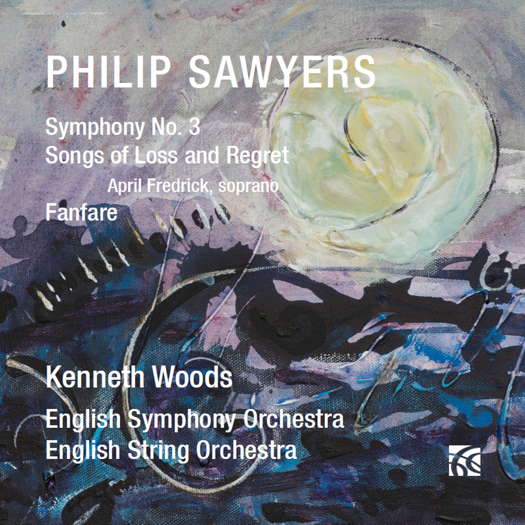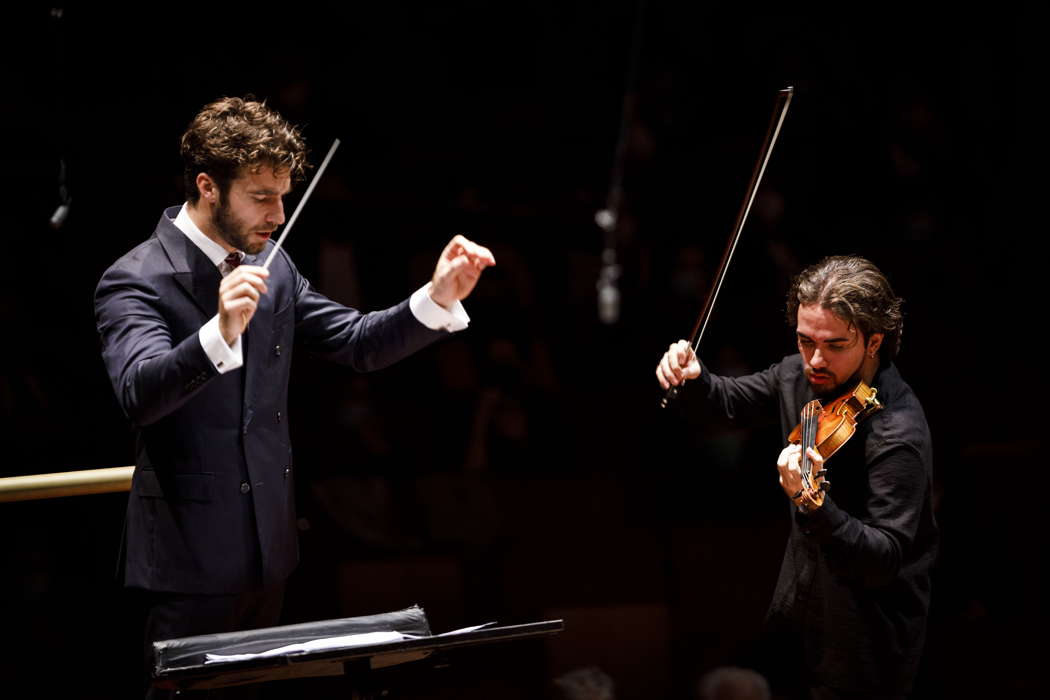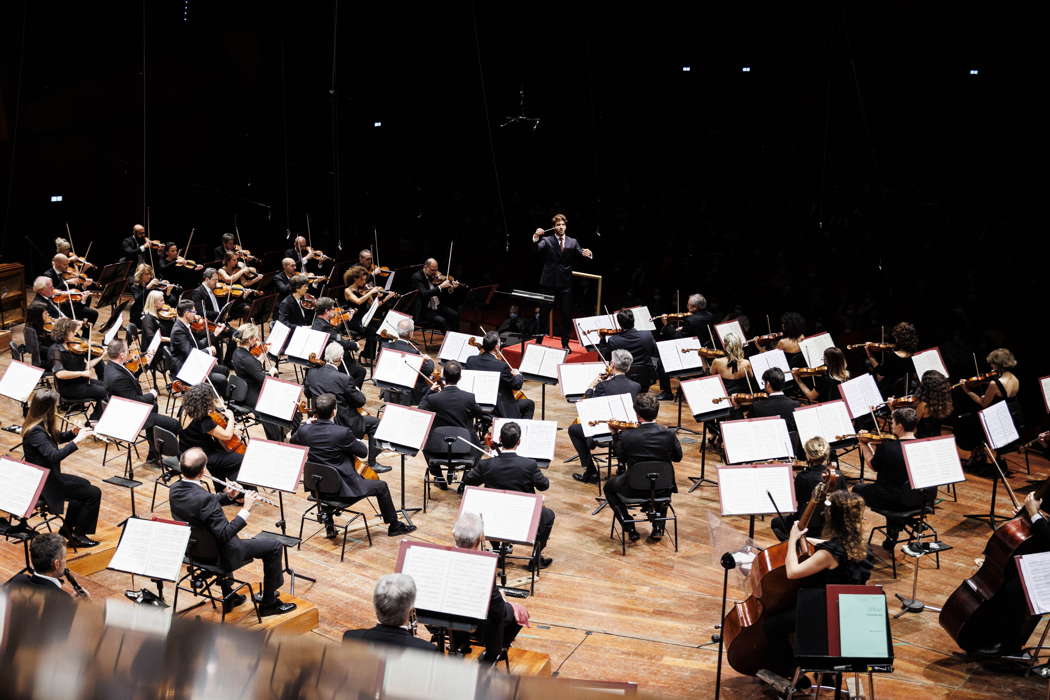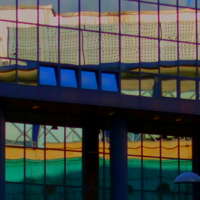 SPONSORED: CD Spotlight. View from the Celli - Philip Sawyers' Symphony No 3 impresses Alice McVeigh.
SPONSORED: CD Spotlight. View from the Celli - Philip Sawyers' Symphony No 3 impresses Alice McVeigh.
All sponsored features >>
Vienna in Rome (with a Surprise)
GIUSEPPE PENNISI listens to Giuseppe Gipponi, Lorenzo Viotti and the Santa Cecilia Symphony Orchestra
On 4 November 2021, before the weekly concert (which is repeated three times) scheduled at the symphony series of the National Santa Cecilia Academy, something happened. The program had been conceived as an evening in which music and atmosphere of Vienna at the turn of the late nineteenth and early twentieth centuries are brought to Rome. The central piece was the highly anticipated but the rarely performed Concerto for Violin and Orchestra by Erich Wolfgang Korngold. The violinist who was to perform it, Veronika Eberle, fell ill and gave forfeit. Another violinist was called in a hurry: Giuseppe Gipponi, twenty years old, from Salerno, the first Italian in twenty-four years to win (less than a month ago) the coveted Paganini Prize. Gipponi does not know the Korngold work (and, of course, could not learn it in a few hours): it was replaced with the Tchaikovsky Violin Concerto, which the Santa Cecilia Symphony Orchestra knows in depth. The Tchaikovsky concerto still has a connection with Vienna, where the first performance took place.
There was only one rehearsal before the concert. Gipponi triumphed; to the ovations and insistent requests for an encore, he offered a 'Capriccio' by Paganini. The ovations continued. Gipponi responded with a second Paganini Capriccio.
On the podium was another young man - the thirty-one year old Lorenzo Viotti. He is already established in Europe - he is principal conductor of the National Orchestra of the Netherlands. He is the son of the late Marcello Viotti, musical director of La Fenice, of whom I still remember a memorable Thaïs and a splendid Ariadne auf Naxos. It was a winning combination, and an evening that began with some fear ended with a great success. The audience of the National Santa Cecilia Academy is returning to Il Parco della Musica; the hall was quite full. Keep the names Giuseppe Gipponi and Lorenzo Viotti in mind: you will hear about them in the future.

Lorenzo Viotti and Giuseppe Gipponi performing at the Parco della Musica in Rome on 4 November 2021. Photo © 2021 Chiara Pasqualini
The evening began with the overture of Die Fledermaus (The Bat) by Johann Strauss Jr, one of Austria's best-known operettas, the only one to be staged (every 31 December) at the Vienna Staatsoper. Viotti, who I had already heard in Salzburg where, years ago, he won the Nestlé competition for young conductors, underlined the ambiguity of the piece: in sparkling and joyful aspects, the piece is imbued with nostalgia for an era that has reached sunset.
The Concerto for Violin and Orchestra in D, Op 35, is Tchaikovsky's only violin concerto. It is well known also because it is used in the films Radu Mihăileanu's Concert, Howard Zieff's Beloved Infidel, and Chen Kaige's Together with You.
It was completed in early 1878 in Clarens, near Montreux, with the collaboration of the violinist Iosif Kotek, who had given advice on the technical aspects of the concerto and was also to be the first performer, proposed by Tchaikovsky himself. At the last moment he gave up due to technical difficulties. Another great concert performer, the famous Leopold Auer, to whom the composition had at first been dedicated, read the score and ruled that it was not possible to play the solo part - he too refused to perform it. The first performance took place three years later, on 4 December 1881 in Vienna, when violinist Adolf Brodsky agreed to play. Tchaikovsky dedicated the score to him. The conductor was Hans Richter. At the first performance, the piece was not appreciated, but today there is no audience that can resist the force of seduction of this composition of about half an hour, divided into three movements - Allegro moderato, Canzonetta: andante and Allegretto.
I have recalled the difficulties that Tchaikovsky had in finding a violinist 'up to the mark' in order to emphasize the virtuosity required in the dialogue between soloist and orchestra, not only in the reckless finale but also in the melancholy of the Andante and in the variations of the first movement. There was great harmony between Gibboni, Viotti and the orchestra.
In the second part of the evening, Viotti and the orchestra tackled two well-known pieces: the suite of Der Rosenkavalier written by Richard Strauss in the last years of the Second World War and La Valse, composed by Ravel in 1920. The first is a synthesis of the 'comedy in music' of 1911 revised thirty-five years later: joy in waltz time mixed with nostalgia for a time dreamed of but that never happened. The second is imbued with nostalgia too as a tribute to the world that disappeared with the First World War.

Lorenzo Viotti and the Santa Cecilia Symphony Orchestra at the Parco della Musica in Rome on 4 November 2021. Photo © 2021 Riccardo Musacchio
Viotti and the orchestra rendered them beautifully.
Copyright © 6 November 2021
Giuseppe Pennisi,
Rome, Italy

MORE CLASSICAL MUSIC ARTICLES ABOUT ROME



